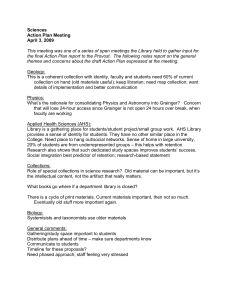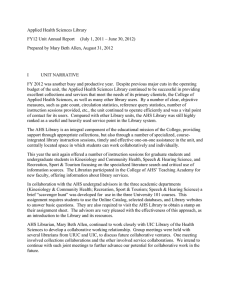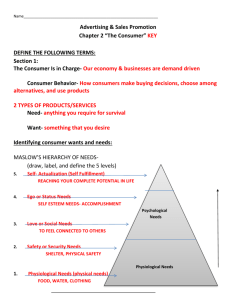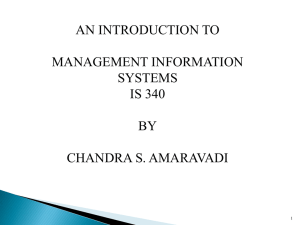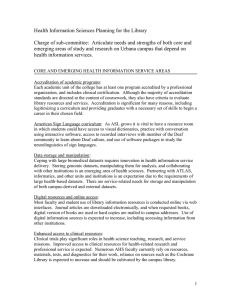Health Information Services Planning Team 10/07/2009 Meeting summary
advertisement
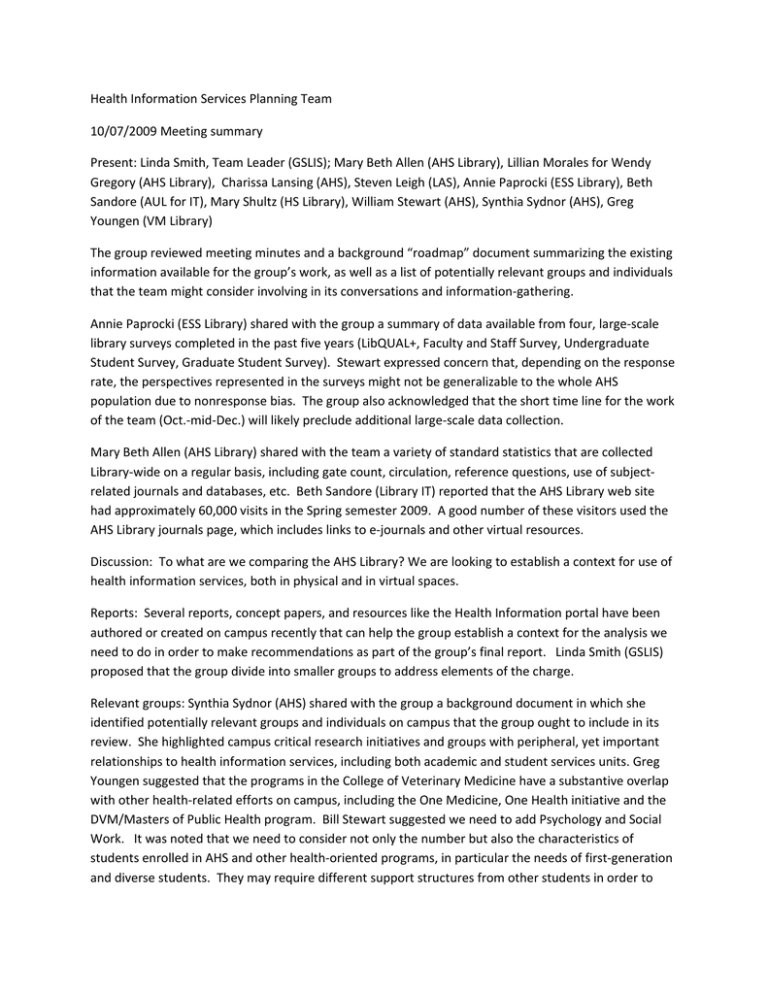
Health Information Services Planning Team 10/07/2009 Meeting summary Present: Linda Smith, Team Leader (GSLIS); Mary Beth Allen (AHS Library), Lillian Morales for Wendy Gregory (AHS Library), Charissa Lansing (AHS), Steven Leigh (LAS), Annie Paprocki (ESS Library), Beth Sandore (AUL for IT), Mary Shultz (HS Library), William Stewart (AHS), Synthia Sydnor (AHS), Greg Youngen (VM Library) The group reviewed meeting minutes and a background “roadmap” document summarizing the existing information available for the group’s work, as well as a list of potentially relevant groups and individuals that the team might consider involving in its conversations and information-gathering. Annie Paprocki (ESS Library) shared with the group a summary of data available from four, large-scale library surveys completed in the past five years (LibQUAL+, Faculty and Staff Survey, Undergraduate Student Survey, Graduate Student Survey). Stewart expressed concern that, depending on the response rate, the perspectives represented in the surveys might not be generalizable to the whole AHS population due to nonresponse bias. The group also acknowledged that the short time line for the work of the team (Oct.-mid-Dec.) will likely preclude additional large-scale data collection. Mary Beth Allen (AHS Library) shared with the team a variety of standard statistics that are collected Library-wide on a regular basis, including gate count, circulation, reference questions, use of subjectrelated journals and databases, etc. Beth Sandore (Library IT) reported that the AHS Library web site had approximately 60,000 visits in the Spring semester 2009. A good number of these visitors used the AHS Library journals page, which includes links to e-journals and other virtual resources. Discussion: To what are we comparing the AHS Library? We are looking to establish a context for use of health information services, both in physical and in virtual spaces. Reports: Several reports, concept papers, and resources like the Health Information portal have been authored or created on campus recently that can help the group establish a context for the analysis we need to do in order to make recommendations as part of the group’s final report. Linda Smith (GSLIS) proposed that the group divide into smaller groups to address elements of the charge. Relevant groups: Synthia Sydnor (AHS) shared with the group a background document in which she identified potentially relevant groups and individuals on campus that the group ought to include in its review. She highlighted campus critical research initiatives and groups with peripheral, yet important relationships to health information services, including both academic and student services units. Greg Youngen suggested that the programs in the College of Veterinary Medicine have a substantive overlap with other health-related efforts on campus, including the One Medicine, One Health initiative and the DVM/Masters of Public Health program. Bill Stewart suggested we need to add Psychology and Social Work. It was noted that we need to consider not only the number but also the characteristics of students enrolled in AHS and other health-oriented programs, in particular the needs of first-generation and diverse students. They may require different support structures from other students in order to thrive at a large institution like Illinois, academically, socially, etc. AHS has a Student Council, with whom Bill Stewart meets on a regular basis. He talked with this group in spring 2009 to gauge their perspective on current Library services on campus. Beth mentioned that the ULSAC (University Librarian Student Advisory Committee) also meets regularly with Paula Kaufman, and Bill added that the group includes 1-2 AHS students. Small groups to address elements of the charge: Linda Smith suggested, and the group agreed, that: Members of the teaching faculty work on #1, articulating needs and strengths of both core and emerging areas of study and research on the Urbana campus. Bill Stewart agreed to lead this group and Mary Beth Allen will also participate to ensure coordination and communication between the two small groups. Other members will include Susan Farner, Charissa Lansing, Steven Leigh, Synthia Sydnor, Kelly Anne Tappenden, and Ken Wilund. Librarians work on #2 (“assess overlap and gaps”) and #4 (“identify exemplars and models”) and #5 (“recommend assessment plan”). Linda Smith agreed to lead this group. Other members include Mary Beth Allen, Annie Paprocki, Mary Shultz, Greg Youngen, and Wendy Gregory. Beth Sandore will be a resource for both small groups. She will be the point person for scheduling small group meetings with the University Librarian’s office. Groups agreed to share their meeting dates and the topics of their meetings in advance with the larger group. Group leaders agreed to share brief summaries of conversations, decisions, actions and questions with the larger group. The group acknowledged the fact that there are potential overlaps in their respective charges, so that crossfertilization can and should occur between the small groups during their investigations. Time frame: October: small groups work on collecting and discussing data. Early November: large group meets to share reports on results of data gathering; begin to brainstorm models for health information services.
